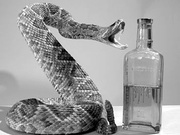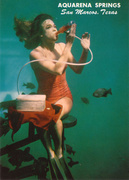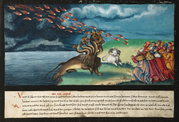
The name Aw Boon Haw is not usually uttered in the same breath as Walt Disney, but both men were wildly successful, marketing-savvy industrialists in the first half of the 20th century, and each is remembered for a theme park. Disney’s industry revolved around the antics of a cartoon mouse. Haw’s fortune was built upon the healing powers of a tiger, the mascot for a salve called Ten Thousand Golden Oil, which was developed by his herbalist father, Aw Chu Kin, in the 1870s. With a leaping tiger on its label, the small, hexagonal jars that Haw and his younger brother, Par, produced in what is now Yangon, Myanmar, were filled with a mixture of camphor, menthol, cajuput, clove, mint, and petroleum jelly, all of which were held in a suspension of wax. Thanks to the creature on its label, the salve became known as Tiger Balm.
In 1908, the ethnically Chinese Aw brothers moved to Singapore, where their medicinal-products enterprise, of which Tiger Balm was the centerpiece, flourished. And it was in Singapore, in 1937, that Haw built the million-dollar Haw Par Villa and Tiger Balm Garden, which included dioramas of painted concrete statues acting out morality tales from traditional Chinese stories and myths, including the graphic and disturbing Ten Gates of Hell.

Tiger Balm has maintained its distinctive hexagonal packaging since the early 20th century.
While the Villa was built as Par’s private home, the grounds were open to the public so that Singaporeans might learn a bit about Chinese culture. In the end, the Villa didn’t last long, torn down shortly after World War II, but Haw kept the garden going, filling it with even more statues and dioramas based on Chinese mythology. After Haw’s death in 1954, Par’s son, Aw Cheng Chye, added areas called “International Corners” to the Garden to dramatize the global appeal of Tiger Balm. That’s why gorillas and the Statue of Liberty can be found incongruously amid the Chinese-themed displays. By the mid-1980s, though, with the grounds in disrepair, the Singapore government took over the property and leased it to a company that rebranded it as Dragon World, charged a $16 admission fee, and turned the Ten Courts of Hell into a boat ride.
Not surprisingly, that incarnation of Haw Par Villa did not last long, and today you can once again wander the grounds, free of charge. While elements of the International Corners remain, it’s the “creepy wonderland”—as many Singaporeans once fondly called it—aspect of Haw Par Villa that shines through amid the 150 dioramas and roughly 1,000 individual sculptures. That’s too many to absorb in a single afternoon, and you’re forgiven if you give up trying read the posted explanations of what you’re looking at. Better to just enjoy the artistry of it all, and to marvel at the obsession of Aw Boon Haw. And if your calves are sore at the end of a day, well, that’s what Tiger Balm is for.

















































 The Real Mermaids of San Marcos, Texas
The Real Mermaids of San Marcos, Texas
 How Snake Oil Got a Bad Rap (Hint: It Wasn't The Snakes' Fault)
How Snake Oil Got a Bad Rap (Hint: It Wasn't The Snakes' Fault) The Real Mermaids of San Marcos, Texas
The Real Mermaids of San Marcos, Texas Storybook Apocalypse: Beasts, Comets, and Other Signs of the End Times
Storybook Apocalypse: Beasts, Comets, and Other Signs of the End Times PharmacyThe neighborhood drugstore, featuring a soda fountain and lunch counter, be…
PharmacyThe neighborhood drugstore, featuring a soda fountain and lunch counter, be… AdvertisingFrom colorful Victorian trade cards of the 1870s to the Super Bowl commerci…
AdvertisingFrom colorful Victorian trade cards of the 1870s to the Super Bowl commerci… Mari Tepper: Laying it on the Line
Mari Tepper: Laying it on the Line Nice Ice: Valerie Hammond on the Genteel Charm of Vintage Canadian Costume Jewelry
Nice Ice: Valerie Hammond on the Genteel Charm of Vintage Canadian Costume Jewelry How Jim Heimann Got Crazy for California Architecture
How Jim Heimann Got Crazy for California Architecture Modernist Man: Jock Peters May Be the Most Influential Architect You've Never Heard Of
Modernist Man: Jock Peters May Be the Most Influential Architect You've Never Heard Of Meet Cute: Were Kokeshi Dolls the Models for Hello Kitty, Pokemon, and Be@rbrick?
Meet Cute: Were Kokeshi Dolls the Models for Hello Kitty, Pokemon, and Be@rbrick? When the King of Comedy Posters Set His Surreal Sights on the World of Rock 'n' Roll
When the King of Comedy Posters Set His Surreal Sights on the World of Rock 'n' Roll How One Artist Makes New Art From Old Coloring Books and Found Photos
How One Artist Makes New Art From Old Coloring Books and Found Photos Say Cheese! How Bad Photography Has Changed Our Definition of Good Pictures
Say Cheese! How Bad Photography Has Changed Our Definition of Good Pictures Middle Earthenware: One Family's Quest to Reclaim Its Place in British Pottery History
Middle Earthenware: One Family's Quest to Reclaim Its Place in British Pottery History Fancy Fowl: How an Evil Sea Captain and a Beloved Queen Made the World Crave KFC
Fancy Fowl: How an Evil Sea Captain and a Beloved Queen Made the World Crave KFC
It’s a little late but I enjoy this article!